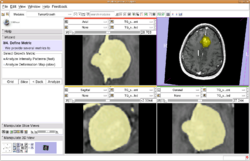Difference between revisions of "SPL-Postdoc"
| Line 10: | Line 10: | ||
==Scope of actvities:== | ==Scope of actvities:== | ||
• Algorithmic research for fast and accurate segmentation of tumors. <br> | • Algorithmic research for fast and accurate segmentation of tumors. <br> | ||
| − | • Research into the analysis of | + | • Research into the analysis of changes over time in images of structures (growth and changes such as necrosis). <br> |
• Add and expand the existing [[media:Slicer3Training_ChangeTracker.ppt|Changetracker tool]] in Slicer 3.<br> | • Add and expand the existing [[media:Slicer3Training_ChangeTracker.ppt|Changetracker tool]] in Slicer 3.<br> | ||
• Contribute to the dissemination of the software by working with [http://www.na-mic.org NA-MIC] and [http://nac.spl.harvard.edu NAC]. <br> | • Contribute to the dissemination of the software by working with [http://www.na-mic.org NA-MIC] and [http://nac.spl.harvard.edu NAC]. <br> | ||
Revision as of 14:15, 26 September 2008
Home < SPL-PostdocJob Posting for Post-doctoral Fellow in Radiology, Surgical Planning Laboratory, Brigham and Women's Hospital and Harvard Medical School
Background:
The Surgical Planning Laboratory is a research laboratory in the department of Radiology of Brigham and Women's Hospital, a teaching hospital of Harvard Medical School. The Core Mission of the SPL is the extraction of medically relevant information from diagnostic imaging data and to concepts of computation and image analysis to new field of biomedical research. The lab collaborates with groups within Brigham and Women's Hospital, with other researchers at the Harvard Medical School, with local universities such as Harvard and MIT, and with clinicians, researchers, and engineers throughout the world.
The goal of this position is to expand the capabilities of an existing oncology research tool for the detection of subtle change in brain tumors from MR images. Desirable new capabilities include handling of multiple time points, changes in size and of the signal intensities as a reflection of biological processes, as well as those suggested by the hired candidate.
Scope of actvities:
• Algorithmic research for fast and accurate segmentation of tumors.
• Research into the analysis of changes over time in images of structures (growth and changes such as necrosis).
• Add and expand the existing Changetracker tool in Slicer 3.
• Contribute to the dissemination of the software by working with NA-MIC and NAC.
Skill Requirements
- Recent PhD in computer science or a related field with deep knowledge in medical image computing (e.g. segmentation, registration and time series analysis)
- Professional programming skills. We expect the candidate to be proficient in C++. Experience in VTK, ITK and 3D Slicer are a plus.
- The candidate should enjoy working in an inter-disciplinary environment with computer scientists and physicians (radiologists, neurosurgeons, psychiatrists, surgeons).
More Information
- Funding for this project is secured for one year.
- Starting date: as soon as practical.
- The successful candidate will split their time in three ways between independent research/activities, project related research and service/engineering.
- For further details please contact Ron Kikinis (kikinis at bwh.harvard.edu).
Brigham and Women's Hospital/Harvard Medical School is an affirmative action/equal opportunity educator and employer.
